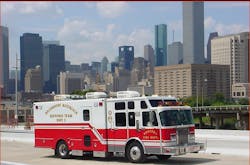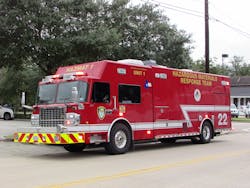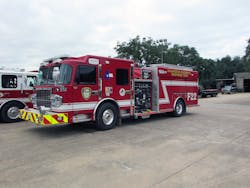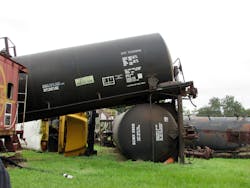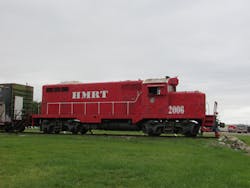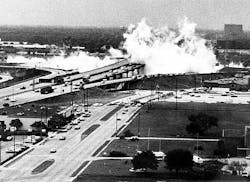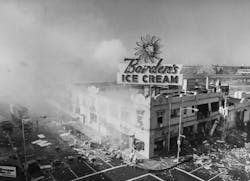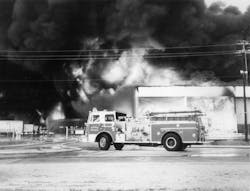On Oct. 5, 2019, the Houston Fire Department (HFD) Hazardous Materials Team, Company 22, will celebrate 40 years of organized hazmat response. A celebration will be held at the HFD Pension Center, with current team members, retired team members, and other department personnel.
HFD by the numbers
Covering 654 square miles, Houston is the fourth-largest city in the United States, with a population of nearly 2.1 million, which swells to over 4.2 million during the day with the out-of-town workers.
Houston's Fire Department is the third-largest in the United States. Samuel Pena is the fire chief, leading 3,900 uniformed personnel, including 21 district chiefs, 10 EMS supervisors, two shift commanders, and three safety officers. The department operates with 87 engine companies, 32 truck companies, three tower ladders, 11 booster trucks (for small fires, brush, trash, etc.), 36 medic units, 56 ambulances, two hazmat units, one hazmat foam engine, three technical rescue units, three air cascades and one rehab truck.
Aircraft rescue and firefighting (ARFF) equipment is located at Houston’s George Bush Intercontinental Airport (IAH) and William P. Hobby Airport (HOU). These include nine ARFF crash trucks, four ARFF trucks, two ARFF medic units, two ARFF rapid-intervention units, one triage vehicle and two ARFF triage trailers.
The department is organized into 21 districts with 93 fire stations and several new ones in various stages of funding, planning, construction and development.
HFD personnel responded to over 335,967 alarms in 2016, including 42,109 fires and 293,858 EMS calls.
Houston ride-alongs
During my trip to Houston in October 2018, I had the honor and privilege to ride with Hazmat 22. Among the responses were a transformer knocked down by a semi/tractor-trailer, which was leaking with live wires down, and a truck fire with possible hazardous materials. I was also given a tour of the Houston Training Academy and the extensive hazmat training props located there.
I also spent a 24-hour shift with my cousin Dustin Schroeder, who is the senior captain at Station 68 on Truck 68. They had a reserve vehicle that day with only four seats, so I rode with Engine 68 throughout the shift, except for an apartment building fire in the evening when I rode with District Chief 8. This was a working fire in a second-floor apartment of a densely populated complex, and the first-in crew made a quick stop.
My experience during these visits was awesome, and I thank all of those responsible for making me feel at home and sharing their on-duty time with me.
Identifying a need
The idea of organized hazmat response by fire departments and other organizations began to develop in the 1970s. Several significant high-profile incidents involving railroad tank cars in Crescent City, IL, Waverly, TN, and Kingman, AZ, resulted in changes in tank car safety, hazmat transportation markings and regulation at the federal level.
Organization of hazmat response teams soon followed, with many established by fire departments. Starting a hazmat team was difficult in the beginning because there weren’t many resources available. There were no guidelines for training from NFPA or OSHA and little information about standard operating procedures and proper equipment. Fire departments relied heavily upon industry and the military for expertise, equipment and training.
Teams that developed as the brainchildren of pioneer leaders, like Chief Russell Yarbrough, Ron Gore, William “Bill” T. Hand and Chief Max McRae, formed in Jacksonville, FL, Houston and other locations. These team formations preceded the Bhopal, India, industrial accident in 1984, which was the high-water mark in getting regulatory attention of the U.S. Congress. Legislation—followed by regulations from the Occupational Safety and Health Agency (OSHA), the Environmental Protection Agency (EPA) and the Department of Transportation (DOT)—ultimately revolutionized hazmat response.
The team’s early years
In Houston, firefighters were recruited for the team from department ranks, some reluctantly. The first hazmat vehicle was an old rescue truck retrieved from the salvage yard. Following several months of training and equipping of the response vehicle, the team was activated on Oct. 5, 1979. The new hazmat team was assigned to Fire Station 1 and would also run rescue calls with a new rescue unit as one of eight rescue teams in the city.
On the team’s first day of service, they were called upon to mitigate a small chlorine leak. An additional 29 hazmat alarms were answered that first year. More hazmat alarms occurred during that first year and through the years to come, but the dispatchers did not always remember that the department now had a hazmat team, meaning other companies were sometimes dispatched instead.
Despite early organization difficulties and growing pains, Houston’s Hazardous Materials Response Team became one of the best hazmat teams in the country. They were used as a model for other fire departments starting their own teams during the 80s and 90s. Hazmat personnel from around the world have ridden with the team through Houston’s Ride-Along Program. Many of the visitors would experience more hazmat responses in a week in Houston than they would in months in their own departments.
Modern-day team
Houston’s Hazardous Materials Team is currently a standalone unit that is dedicated to hazmat response and other hazmat duties. Team quarters moved from Station 1 to Station 17, Engine 22, Ladder 22 and Medic 22, and then relocated 20 miles to its current quarters, located at the former Engine 22 Station (Engine 22 and Ladder 22 were taken out of service). Hazmat 22 currently operates out of relocated Station 22 at 7825 Harrisburg St. Station 22 is close to the city’s petrochemical area, and hazmat units have a 20–25-minute response time anywhere in the city.
Station 22 is home to two hazmat response units. Hazmat Unit 1 is a 2015 Spartan, and Unit 2 is a 1995 Super Vac. Also located at Station 22 is Foam Engine 22, a 2016 Spartan Gladiator with a 2,000-gpm pump, 500-gallon water tank, 750-gallon foam tank, 1,000 feet of 4-inch hose, and a Williams Hot Shot II 90-gpm foam system. Foam Engine 22 also carries decontamination equipment and can respond alone on some types of hazmat alarms.
Hazmat 22 responds to, on average, more than 1,400 alarms per year. During 2017, one civilian died and 22 were injured as a result of exposure to hazardous materials. There were no hazmat team deaths or injuries.
Engine companies throughout the city carry 10 gallons of hydrocarbon dispersant for use on small fuel spills. Anything larger requires the response of the hazmat unit.
Houston uses Scott 4.5 SCBAs with one-hour bottles. Chemical suits are Kapler Responder for Level A and Kapler CPF 2 and 3 for Level B. They have both encapsulated and non-encapsulated Level B suits. The team uses Scott in-suit communication systems.
Monitoring equipment carried on the hazmat unit includes four-gas meters, MiniRAEs, Sol Mini-CAD, radiological instruments and Smiths APD 2000.
Reference materials consist of the Emergency Response Guidebook, the Bureau of Explosives book, Hawley’s Condensed Chemical Dictionary, a pesticide manual, various military agent books, as well as a laptop computer with CAMEO (Computer-Aided Management of Emergency Operations), a system of software applications used to plan for and respond to chemical emergencies.
Houston’s hazmat personnel operate as a team with a great deal of confidence in their abilities and each other. Captains function like quarterbacks and not coaches, with Kevin Okonski serving as the team coordinator. There are normally 11 hazmat techs on duty each shift, and there are approximately 69 additional hazmat techs in reserve.
Firefighters who want to be on the hazmat team must have five years on the department, submit an application, and pass the Houston Tech Course. All hazmat team personnel undergo annual physicals. All firefighters are trained to the Operations level.
Major hazmat incidents
Houston has faced several major hazmat incidents over the years.
I-610 at Southwest Freeway Ammonia Tanker Incident
The worst transportation incident to occur in Houston happened on May 11, 1976. This incident occurred a little more than 2 years before the hazmat team was formed. An MC331 tanker truck hauling 7,509 gallons of liquid anhydrous ammonia struck and penetrated a bridge rail, then struck a support column and fell approximately 15 feet to the Southwest Freeway below. All of the ammonia was released from the tank and ultimately resulted in six fatalities, 78 hospitalizations and approximately 100 other persons treated for exposure to the ammonia. If the location had been in downtown Houston—next to office buildings, apartments or a congested residential area—there could have been many more injuries and fatalities. As a result, the City of Houston created designated routes for hazardous materials transported within the city to avoid such vulnerable areas.
Mykawa Train Yard Vinyl Chloride BLEVE
On Oct. 19, 1971, the HFD experienced a tank car incident on Mykawa Road, resulting from a train derailment. Two tank cars of vinyl chloride monomer ignited. There were six cars of vinyl chloride, and one each of acetone, caustic soda, formaldehyde, plasticine and butadiene. The butadiene tank car experienced an explosion, resulting in one firefighter fatality and 37 firefighter injuries. Photographs and video of this incident have been circulating through the fire service for years showing Firefighter Andy Nelson on an aerial ladder engulfed in flames and smoke following the explosion. Firefighter Nelson was burned but survived.
It was thought that it was the Mykawa incident that motivated then-District Chief V.E. Rogers, who was also burned at the incident, to form a hazmat team in Houston. The real story: The team was formed as a result of Rogers attending a fire conference at which a presentation was made by Ron Gore about the new Jacksonville, FL, Hazardous Materials Response Team. Rogers returned home and directed McRae, then a district chief, to organize Houston’s hazmat team.
Explosion at Borden's Ice Cream Plant
Another ammonia incident occurred on Dec. 11, 1983, when the Borden’s Ice Cream plant experienced an explosion from leaking anhydrous ammonia used for cooling at the plant. There were no deaths or injuries.
Several events delayed firefighters from entering the building before the explosion, which certainly would have caused firefighter injuries, if not death. One such delay occurred when firefighters outfitted the plant engineer with SCBA and provided impromptu training, so he could enter with them and identify a leaking valve. The explosion occurred as they walked toward the building. Hazmat personnel had not yet arrived on scene, and that may have saved them from injury and death as well.
At the time, there was a great deal of surprise among firefighters that ammonia would burn or explode. Previous procedures were to enter the building with chemical protection and stop the leaks. Following this incident, procedures were changed to ventilate the building thoroughly before entering to plug leaks.
Houston Distribution Warehouse Complex
One of the largest fires to ever challenge the HFD occurred on June 24, 1995. Seven alarms were transmitted for the Houston Distribution Warehouse Complex located at 8550 Market St., starting with the first one at 8:33 a.m. Two-thirds of the city’s on-duty force was called upon to fight the stubborn fire over the next 31 hours. Thirty-one engine companies and 14 ladder companies fought the fire. Warehouses in the complex were loaded with organic and inorganic chemicals, including corrosives, motor oils, plastics, solvents, cleaning compounds, lubricants, organo-phosphorus pesticides, flame retardants and metallic compounds.
Exposures included five tractor-trailers loaded with organic peroxides and a liquefied petroleum gas rail car. Lines were placed in service to protect exposures, and protective booms were placed to keep runoff water from entering storm drains. Mutual aid was requested from Channel Industries Mutual Aid (CIMA) at 7:30 p.m., which brought 10 foam tankers, four 2,000-gpm monitors mounted on trailers and a 6,700-gallon foam tanker to the scene.
After pouring foam on the fire all night, firefighters brought it under control at around 3 a.m. the following morning. Fire units remained on scene for several days putting out flare-ups. Despite the magnitude of the fire and the chemicals involved, only three firefighters sustained minor injuries.
For more information
For questions or additional information about the HFD Hazmat Team, contact Kevin L. Okonski, hazmat team coordinator, at [email protected].
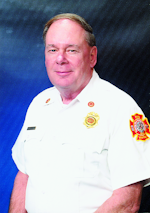
Robert Burke
Robert Burke, who is a hazardous materials and fire protection consultant and who served as a Firehouse contributing editor, is a Certified Fire Protection Specialist (CFSP), Fire Inspector II, Fire Inspector III, Fire Investigator and Hazardous Materials Specialist. He has served on state and county hazmat teams. Burke is the author of the textbooks "Hazardous Materials Chemistry for Emergency Responders," "Counter-Terrorism for Emergency Responders," "Fire Protection: Systems and Response," "Hazmat Teams Across America" and "Hazmatology: The Science of Hazardous Materials."
